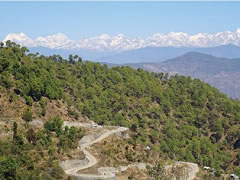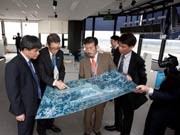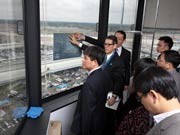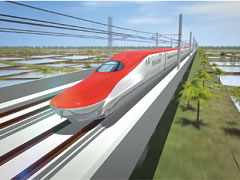Case Study
Nepal: Project for the Construction of Sindhuli Road
A 160-km Artery Supports Community Life
Since Nepal is a landlocked country, roads are vital, accounting for most of the country'stransportation. However, road construction is no easy task in the mountainous country. In fact, Nepal's per-capita road length is the shortest in South Asia. Access to reliable and wellmaintained roads is a major concern for people in rural areas. Even the trunk road that has long connected the capital city of Kathmandu in the north and the Nepal-India boarder in the south has sometimes been rendered impassable for long periods due to landslides caused by torrential rain, even though it is an economic lifeline for the landlocked country.
To rectify the situation, JICA launched a development study in 1986, which identified a new route that will connect Kathmandu with the Indian border. From 1995 onward, JICA supported the construction of this road, known as the Sindhuli Road, with ODA Grants. In March 2015, the whole road, totaling 160 km in length, was put into use.
The road, which took more than 20 years to complete, has brought gradual but positive changes to the people living along the road corridor. For instance, their income has increased due to significantly reduced transportation costs and time that have been brought about by the new road. Some farmers now use fertilizers and can transport milk and Junar oranges to urban areas. The new road has greatly contributed to improved education and health care as well.
In April 2015, soon after the completion of the road, Nepal was struck by a powerful earthquake with a magnitude of 7.8. Everyone who was involved in construction of the road worried that the Sindhuli Road might be damaged, but the road remained passable without major damage. As a matter of fact, the road was packed with vehicles carrying relief supplies and others carrying people who were fleeing from Kathmandu to the provinces. Indeed, the Sindhuli Road became a path that saved Kathmandu's citizens in a time of need.

The Sindhuli Road meanders through the Mahabharat Range, with the Himalayas in the background. (Photo: Nippon Koei Co., Ltd.)
Case Study
Viet Nam: Noi Bai International Airport
Laying the Groundwork for Package Infrastructure Overseas Operations
The number of passengers was increasing rapidly at Noi Bai International Airport, which serves Hanoi, the capital of Viet Nam. The passenger terminal that had been designed to accommodate 6 million passengers every year was already far above capacity, having served 9.5 million passengers in 2010. JICA extended an ODA Loan to construct a second passenger terminal at this airport and is assisting in the establishment for systems to operate and maintain the terminal.
Rapid Growth in Passenger Volume
Expanding the passenger capacity of Noi Bai International Airport was vital to the continued growth of Viet Nam's economy. In 2010, JICA signed an ODA Loan agreement for the Terminal 2 Construction Project in Noi Bai International Airport. The loan was for construction of a second passenger terminal, which raised the airport's annual capacity to 10 million passengers, along with all associated facilities. The terminal began operations in 2015.
Plans called for Terminal 2 to incorporate state-of-the-art technology used for the first time in Viet Nam. To allow Airports Corporation of Vietnam (ACV) to properly operate and maintain the terminal after the building has been completed, the project required quickly creating the necessary organization and training program within the limited time that was available. Concurrent preparations also included coordination with associated agencies and other measures.
In response to the requests of ACV, JICA used an aid scheme (loan account Technical Cooperation) to provide know-how concerning airport operations that use public-private partnership. The goal was to maximize the development benefits by using knowledge and experience about the operation and maintenance of state-of-the-art Japanese systems so that Terminal 2 can be fully utilized.

Opinion exchange among public and private relative parties
Using Public-Private Partnership to Establish a Framework for Aid from Japan
The Terminal 2 Concurrent Preparations Committee was formed in November 2011 primarily to provide centralized oversight of preparations involving the airport project. Committee members came from the associated agencies of Japan and Viet Nam. The committee was chaired by the president of ACV. Other members from Viet Nam were directors of ACV and managers of departments involved in the project. Committee members from Japan came from JICA, the Ministry of Land, Infrastructure, Transport and Tourism Civil Aviation Bureau and Narita International Airport Corporation. Furthermore, since the Special Terms for Economic Partnership (STEP) were applied to this project, Japanese companies were serving as the contractors and construction supervision consultants. Under this entirely Japanese framework, the strengths of each company would be leveraged to extend support for the construction as a public-private partnership of a passenger terminal with highly advanced operating systems. The goal of this support was to enable ACV to conduct sound airport management.

Individuals involved in the Terminal 2 project in Viet Nam tour Narita International Airport
Japan's First Management Support for Operating a 10 Million Passenger Terminal
This project was the first case that Japan had extended support for the operation of an enormous airport terminal. Assistance involved establishing a committee with authority to oversee progress with concurrent preparations, the use of a JICA aid scheme, and the participation by Japan in a committee that uses private-public sector collaboration. The infrastructure project was being conducted as a single package that combined the building and other facilities with support for management skills. Using this approach could make it possible to take full advantage of Terminal 2's capabilities in order to increase the development effectiveness of this project.

Individuals involved in the Terminal 2 project in Viet Nam tour Narita International Airport
Case Study
Conducting Survey for Development of the First High Speed Railway System in India, Superpower in the 21st Century
Indirectly Supporting Japanese Companies in Exporting Infrastructure
With a steep increase in the traffic volume of people and goods due to recent rapid economic growth, it has become urgent for India to develop intercity transport systems. The Ministry of Railways of India (MOR) drew up the Indian Railways Vision 2020 in December 2009 and has sequentially started prefeasibility studies on seven potential High Speed Railway (HSR) corridors. The section between Mumbai and Ahmedabad is identified as the first priority corridor.
In the joint study conducted by MOR and JICA, the alignment plan of the first HSR in India was developed by considering various factors, including environmental and social conditions as well as demand forecast. By conducting detailed comparison and examination of HSR systems throughout the world from the viewpoints of safety, reliability, rationality, meteorological conditions, cost for both construction and operation, and so on, the joint study finally proposed the most suitable HSR system for India by taking the above viewpoints and various conditions of India into consideration, including civil structure, rolling stock, signaling and telecommunication systems, and operation control systems. JICA also studied a wide range of matters, such as technical specifications, construction plans, project/financial schemes, implementation structures, operation and maintenance plans, and human resources development plans. These issues were concluded after a series of close mutual discussions and cooperation between JICA and MOR.
The final report of the joint study was submitted in July 2015, and the Memorandum of Cooperation on HSR was signed between Japan and India in July 2015. It was confirmed that MAHSR would be developed with the use of Japanese HSR technologies (i.e. Shinkansen system) and experiences, in line with the results of the joint study on MAHSR. The Japanese Government has shown its interest in providing India with financial, technical, and operational support for the introduction of an HSR system by utilizing Japan's Shinkansen system. Based on such policy, JICA also intends to provide ODA loans and technical assistance, including human resources development, for project implementation. In this regard, "The Follow-up Study for Mumbai-Ahmedabad High Speed Railway Corridor" has been implemented since March 2016, for providing technical assistance for introducing safety certification system for the first HSR in India and drawing up the standards of various technical specifications and development plan of stations and their surroundings. In addition, "General Consultancy of the Mumbai-Ahmedabad High Speed Railway Project" has been on-going since December 2016 to provide technical assistance related to drafting specification, bidding documents, etc.
Railways, including HSR and urban railways, have been drawing international attention as environmentally friendly modes of transportation. Various types of HSR projects are planned, especially in Asian countries, such as Thailand, Malaysia, Indonesia, and Viet Nam, with remarkable economic growth. While addressing the development needs of developing countries, JICA will continue to support Japanese companies to expand their operations to overseas countries based on the cooperative relationships with partner governments.

Image of India's High Speed Railway




scroll